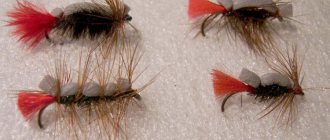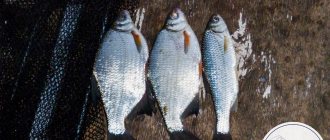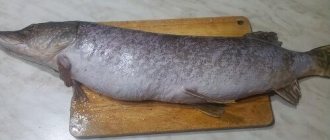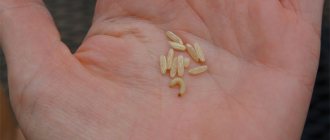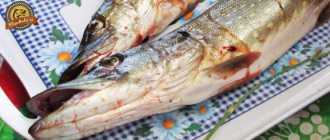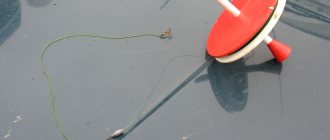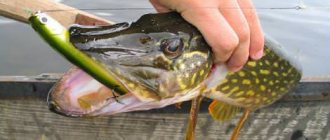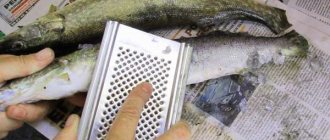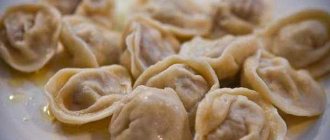How tasty and appetizing is fish soup made from fresh pike just caught in the river! But before you prepare any dish from it, you need to learn how to properly clean pike. We'll tell you step by step how to do this.
Do you like pike dishes?
- Yes 86%, 4064 votes
4064 votes 86%4064 votes - 86% of all votes
- No 10%, 491 votes
491 votes 10%
491 votes - 10% of all votes
- I don't eat fish 3%, 156 votes
156 votes 3%
156 votes - 3% of all votes
Total votes: 4711
18.06.2020
×
You or from your IP have already voted.
How to remove mucus
Live fish are covered in debris and a thin layer of mucus. It becomes especially abundant in the summer. The water warms up, and the pike needs to maintain the required body temperature.
In order to remove mucus, it is correct to first rub the fish with salt. Then it should be thoroughly washed in the sink under running warm or hot water for 3-5 minutes. After this, wipe the carcass with a paper or waffle towel.
Advice from an experienced cook! It is better to remove scales from fresh fish immediately. It can be easily removed by hand.
Useful properties of pike
Pike is a freshwater fish from the pike family. It grows up to 150 cm in length, its weight is from 2 to 35 kg. It is valued for its satiety and low calorie content. It is best to choose fish weighing 2–2.5 kg for the table, as its meat is tender and juicy. The most popular dish is stuffed pike.
This fish has many beneficial properties.
- It has low calorie content: 100 g of meat contains only 84 calories and up to 3% fat.
- Is a natural antiseptic. Natural antiseptics are much healthier than chemical ones, as they help cope with various infectious diseases and strengthen the immune system.
- Contains many vitamins, macro- and microelements.
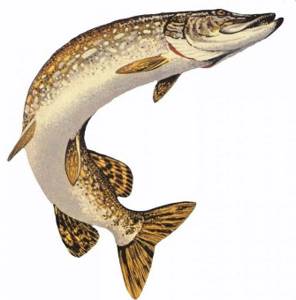
Pike is a healthy and tasty fish that is available to everyone
Content of vitamins, macro- and microelements in 100 g of pike meat - table
| Vitamins | |
| Vitamin A | 0.01 mg |
| Vitamin B1 | 0.11 mg |
| Vitamin B2 | 0.14 mg |
| Vitamin B6 | 0.2 mg |
| Vitamin B9 | 8.8 mcg |
| Vitamin C | 1.6 mg |
| Vitamin E | 0.7 mg |
| Vitamin PP | 3.5 mg |
| Macro- and microelements | |
| Calcium | 40 mg |
| Magnesium | 35 mg |
| Sodium | 40 mg |
| Potassium | 260 mg |
| Phosphorus | 200 mg |
| Chlorine | 60 mg |
| Sulfur | 210 mg |
| Iron | 0.7 mg |
| Zinc | 1 mg |
| Iodine | 50 mcg |
| Copper | 110 mcg |
| Manganese | 0.05 kg |
| Chromium | 55 mcg |
| Fluorine | 25 mcg |
| Molybdenum | 4 mcg |
| Cobalt | 20 mcg |
| Nickel | 6 mcg |
Cleaning scales with a knife
The next stage of pike preparation is scraping off the scales:
- We remove unnecessary items from the cutting table and stove so as not to stain them;
- We empty the sink in advance;
- Cover the work surface with newspaper or film;
- Place a napkin under the cutting surface to prevent slipping;
- You need a plastic or glass board on which to place the fish;
- We put on cotton gloves;
- Take a wide, well-sharpened knife;
- We clean the scales starting from the tail, as if prying it from below;
- We hold the tail fin with our hand and first clear the scales on one side;
- Then you should turn the fish over on the other side and remove the scales from it;
- We remove the remaining scales with gloved hands;
- At the end of the work, you should rinse the carcass with water from above and from the inside.
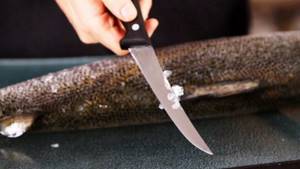
This is interesting! To clean fish from scales, you can use a fork, scraper or other special device (a fish scaler with a container).
Cleaning on the go
Processing fish at home is, of course, convenient. But what about those who decide to do it in nature? What fisherman wouldn’t want to boil fish soup or fry a couple of pike from a fresh catch? To do this, you need to prepare it. How can you clean a pike from scales right on the street without the usual conditions and tools? But fishermen are a people accustomed to everything. Any of them can do this in literally 2 minutes. For such purposes, each of them always has a small device in their travel bag. You can easily do it yourself. To do this, you will need a piece of board no more than 20 centimeters long and a couple of metal caps from glass bottles. The board needs to be cut lengthwise to create a blank for the handle. To avoid injuring your hands during work, it is better to process and sand it with sandpaper. On one side, secure the plugs one behind the other using regular nails. Such a simple device is easy to make at home in advance. But at the right time, you can use it to clean even the smallest fish.
How to gut a pike
The next stage of cutting fish is gutting it.
- Using scissors, carefully cut off the sharp fins and tail;
- Using a knife, cut the cartilage between the head and belly;
- We cut the belly of the pike along the entire cavity from the anus to the head. The incision should be shallow, otherwise the gallbladder may be damaged. If bile has spilled onto areas of the fish, treat them with salt.
- Carefully cut off the insides and remove them;
- We take out the gills and the white film located along the inner part of the ridge (air bubble), remove the blood clots under it;
- If the pike is then filleted, the head of the fish should not be removed.
There is no need to throw away the liver, fins, head and tail of the pike. They are used to prepare fish soup.
As a result of these simple manipulations, the pike will be left with an almost finished fillet.
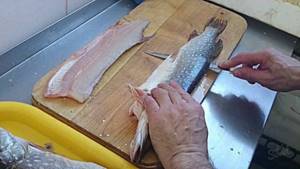
Important! The gills of the pike must be removed; they give bitterness to the finished dish.
If you decide to cook fish soup or fry pike, then it should be cut into pieces. If you plan to cook cutlets, then proceed to the next stage of cutting. Before doing this, rinse the fish again inside and out under clean running water.
Important details
In the complex process of preparing fresh fish for further culinary processing, there are several important points that need to be understood in order to have a complete understanding of how to clean pike:
1) First you need to remember that for such work you will need a large amount of water and a very sharp knife. As you know, pike scales are very small and need to be washed off periodically during cleaning. In addition, the fish itself is covered with a layer of natural mucus. It's not easy to remove. This will require a lot of water.
2) It is necessary to scrape scales from the surface with smooth, confident movements, holding the knife at a slightly angle to the fish. This will make the job much easier and prevent small scales from flying all over the kitchen.
3) You need to cut the belly very carefully. Do not stick the knife deep into the body of the fish. This can damage the gallbladder and spoil the meat. A smooth cut from the head to the anus will be sufficient.
4) When removing the insides, you can see a thin transparent film near the spine, under which there are small bloody clots. All this must be removed.
Fish scales perform a protective function, but are completely unsuitable for food. However, it is worth noting that it contains many rather rare and at the same time useful substances. Therefore, if the pike is used exclusively for cooking, then it does not need to be cleaned. This leads to two ways to properly clean a pike:
1) The scales along with the entrails are removed before cooking.
2) The scales, along with the skin and bones, are separated from the meat after cooking. This option is used if you are going to cook, for example, fish cutlets.
There is one more golden rule. The scales need to be removed only when the insides are removed. You should not separate these two processes, since they are fundamentally interrelated with each other. Sometimes you come across fish with rather dense scales. In this case, the fish should be slightly steamed by dipping it briefly into a container of boiling water. And, of course, every housewife knows how to properly clean a pike so as not to cover the entire room with scales. In addition to a sharp knife, you will also need a regular plastic bag. The cleaning process will take place inside it, which will prevent the possibility of waste being thrown around.
Filleting
Pike fillet is used to prepare minced meat for meatballs, pies, pies, and dumplings. You can also fry the fillet pieces in oil.
Curious! You need to cut fish on any board except wood. It absorbs various odors very well.
The carcass should be filleted with a sharp knife as follows:
- We make a cut at the base of the head to make it more convenient to hold the pike;
- We fix the left hand in it;
- Place the pike on its left side and continue cutting it to the spine;
- When the knife hits the ribs, we stop;
- We divide the fish into two parts from head to tail, placing the knife parallel to the ribs;
- Place the resulting halves skin side down and separate the meat from the tail with a knife;
- We remove all visible large and small bones using tweezers;
- The last step is to carefully remove the skin by picking it up with kitchen tweezers or regular pliers.

Simple and fast
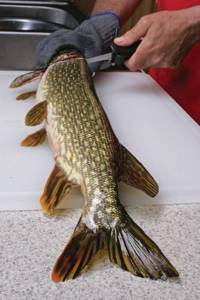
Cutting pike is a long and rather dirty process. But experts have come up with a way to clean pike quickly and with virtually no debris. For this you will need: a cutting board, a knife and a fillet fork. Now you need to correctly perform the following steps:
- Place the washed fish on a board.
- Cut out the middle fin, and behind the front one make a cut towards the head.
- Having reached the ridge, unfold the knife and continue cutting along the ridge right up to the tail. It turns out exactly half the carcass. Then turn the other half over and do the same with it.
- Separate the ribs from each half, carefully cutting them off with a fillet knife. At this time, you can hold the fish with a fork.
- Now, alternately, separate the skin from each half along with the scales. To do this, place a piece of fish on the board, skin side down, and carefully make a cut with a knife, slowly moving it along the table.
The result is two pieces of pike meat. And the fish turns out to be cleaned without dirt and without scales.
Lemon and boiling water cleaning method
Advice to the hostess! Removing pike scales will happen without problems and even faster if you scald it with boiling water.
- Place the fish in the sink;
- Pour boiling water over both halves of it alternately, holding it by the tail;
- We clean the scales using the method described above;
- Rub half a lemon on the pike for two to three minutes;
- Cut off the fins;
- We remove the cartilage located at the junction of the head and belly;
- We cut the bottom of the pike lengthwise from the gills to the caudal fin;
- Carefully remove the insides;
- We take out the gills, the air bubble;
- Before cooking, you need to once again treat all surfaces of the fish with lemon juice.
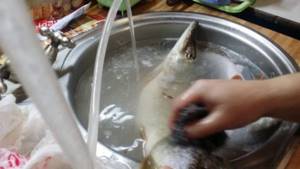
Lemon can be constantly used when cleaning pike and other river fish. It relieves her of the unpleasant smell of mud.
Cleaning with a Karcher
This method is suitable for very lazy car enthusiasts. When you have a car karcher at hand, you can very quickly clean a freshly caught live pike with it.
- We secure the tail of the fish on the board with a large clothespin or simply press it down with our foot. You can stack several carcasses at once.
- We turn on the Karcher;
- We begin to smoothly move the water pressure along the back of the fish, starting from the tail. Pike scales come off easily and instantly!
- You need to keep the pressure as close to the fish as possible;
- First remove the scales on one half, then turn over and clean the other side.
In this case, you do not need to wash the fish first. The entire procedure goes smoothly and takes no more than five minutes.
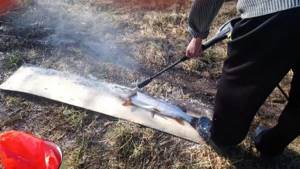
Parting words from an experienced chef! Never clean this fish by sticking your fingers into its mouth. Living specimens have many sharp teeth in their mouths that can stick into your hand.
Preparatory work
In warm weather, if possible, it is better to clean fish outside, where there are no problems from scales flying to the sides and splashes. In the kitchen, before cleaning the pike, you need to prepare the place and the necessary supplies in advance so that you do not have to wash your hands several times during the work.
- Absolutely all utensils and accessories must be removed from the cutting table and the nearby gas stove; it is better to cover the stove and nearby furniture with paper or polyethylene.
- Empty the sink completely, prepare a stopper so that you can fill the sink with water (or use a larger container).
- Prepare a cutting board of sufficient size. It is desirable that it be made of plastic or glass. A fishy smell is absorbed into the wood, which will be difficult to get rid of later.
- To prevent the board from sliding on the tabletop while working, you can place a damp cloth or an old towel under it.
- You will need a cutting knife, preferably with a wide blade. You can clean the pike with the same knife, but it is more convenient to use a special cleaner, which you can buy at a hardware store. It is best if it comes with a container for scales.
- Wearing work gloves on your hands (at least on the left one) will make it more comfortable to hold the fish and reduce the likelihood of getting hurt.
- You can prepare a couple of pinches of coarse salt. If you sprinkle it on the tail of a pike, it will not slip out of your hands while working.
It is advisable to carry out these preparatory work when cutting any fish that has not been scaled.
How to clean frozen pike
How to clean pike if you bought it frozen in a store?
- The fish should be defrosted at room temperature;
- Wash it under running water;
- Using a sharp knife, cut off all the fins in the shell;
- Clean off the scales;
- In the area where the head meets the body, we make a deep incision;
- We cut the belly and back from head to tail;
- Use pliers or special tongs to grab the edge of the skin and remove it;
- Cut off the head;
- Cut out the insides;
- Cut the pike into pieces approximately 5 centimeters wide;
- Carefully cut the flesh from the spine.
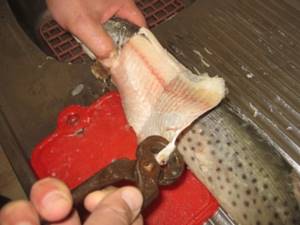
Advice from a cooking guru! Before putting caught or purchased pike in the freezer, it should not be washed or cleared of mucus. This will subsequently worsen the taste of the finished dish.
Now you know all the life hacks for cleaning scales from this healthy fish and processing it.
How to separate fillet from bones
If, for example, you are preparing cutlets, you will only need meat, without the slightest bones. In this case, removing the scales and skin is not all you have to worry about. You will need to properly remove the flesh from the backbone and ribs.
This problem can be solved in several stages:
- A longitudinal incision is made on the back. Now the fish is divided along the entire spine. The pulp will be along with the rib bones. You will get two pieces of fillet: one will have the spine, and the other will have only the bones from the ribs.
- After removing the ridge, two layers of pulp will remain. First you need to clean off all the scales. This cutting is convenient for subsequent boiling of pike, frying, and preparing minced meat.
- To immediately obtain pieces of boneless pulp, proceed as follows. First, the fish is layered, as already described. Then each strip is laid out on the board, skin side down. Holding the ribs with your left hand, cut them off with your right, holding the blade at an angle, capturing more meat. The pulp can be removed from the skin. Now the fillet is cut into the required pieces and poached or fried in batter, and the backbone with the remaining pulp is useful for fish soup.
Helpful Tips:
- The easiest way to clean freshly caught pike.
- When gutting, do not damage the gall bladder so that the meat does not become bitter.
- If the pike was frozen, it can only be thawed in cold water. There should be no dents or tears on the pike, otherwise the flesh will lose its taste and nutrients.
- If the mucus from the fish is washed away, but the specific river smell remains, rub the carcass with fresh lemon juice. Dip the carcass in a brine solution (a glass of salt in a three-liter jar of water) or vinegar (2 tbsp/l of water).
- You can remove all small seeds from the pulp using ordinary eyebrow tweezers.
- It is convenient to get rid of scales using a metal scraper or a curved knife. They also use a knife-brush (shaped like a fish and has many sharp teeth) and a manual fish scaler with a tray for scales (it is made of durable plastic and equipped with a lid so that the scales do not fly apart).
- For smoking or frying, the most delicious pike is the one caught from February to April.
Cleaning fish is not the most pleasant process. But knowing a few tricks, it can be significantly speeded up and simplified. If you often deal with fresh fish, you should consider purchasing special kitchen utensils and a board with a holder. They will help save effort and time, and you will enjoy delicious pike dishes, and the inconvenience associated with cleaning it will be a thing of the past.
The video will tell you about cleaning pike:
In order to prepare tasty and healthy fish dishes, you need to know how to clean a pike so as not to litter the entire kitchen with small scales and not hurt your hands. Having the necessary knowledge and skills, this is not difficult to do. There are only a few features of how you can quickly free a predator from its scales and cut up the carcass for preparing a particular dish.
